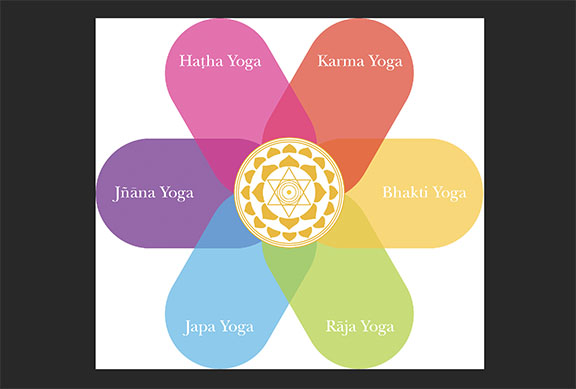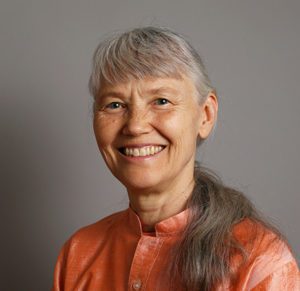 In this article, Integral Yoga master teacher, Swami Vidyananda explains that Yoga practice can help us win many battles with illness and suffering. And while Hatha Yoga and pranayama are powerful therapeutic tools, on the level of the body, we will all ultimately lose the war because we will all die one day. That’s when the subtler practices of Yoga—Karma, Bhakti, and Raja Yoga— can relieve suffering and provide a deeper healing.
In this article, Integral Yoga master teacher, Swami Vidyananda explains that Yoga practice can help us win many battles with illness and suffering. And while Hatha Yoga and pranayama are powerful therapeutic tools, on the level of the body, we will all ultimately lose the war because we will all die one day. That’s when the subtler practices of Yoga—Karma, Bhakti, and Raja Yoga— can relieve suffering and provide a deeper healing.
Raja Yoga
In the Yoga Sutras of Patanjali, we learn that the root causes of suffering are the kleshas: Avidya is ignorance of our true nature as spirit. Asmita is the ego sense—the sense of a separate self. Illness and death are the consequence this illusion. Real healing occurs when we identify with our true Self as spirit. Then the body goes through what it has to experience due to karma, but we can experience the Self as spirit, as whole and happy throughout all the changes. This understanding is the container holds all the therapeutic practices of Yoga.
When we understand the concept of karma, we are better able to make sense of suffering. Suffering is not the enemy. Even though we do everything we can to relieve suffering, through it, we earn our freedom from the negative effects of past actions. And it provides us with a powerful impetus to seek deeper knowledge and to wake up from the illusion of a separate self.
When we study and assimilate this wisdom, we can become instrumental in helping others to transform themselves through acceptance of their illness, weakness, and mortality. We can embody a healing presence, even when we don’t specifically speak about Yoga or teach a particular technique.
Bhakti Yoga: Devotion as Therapy
One of the things that drew me to Swami Satchidananda was his interfaith teachings. He taught us to love and respect all faiths. There is only one ultimate truth that we call God and that expresses through every spiritual tradition.
Some years ago, I was visiting a friend in the hospital, and she told me that the woman with whom she shared the room seemed very depressed. This woman, whom I will call “Aisha” (not her real name), was an older Muslim woman, far from home, who spoke almost no English. Aisha’s daughter worked and could only visit briefly at night. My friend asked me if I would try to cheer up Aisha. So, I took a flower from my friend, “knocked” on the curtain, and offered Aisha the flower. She smiled at weakly and nodded her thanks. I didn’t know any Muslim prayers by heart. So I simply closed my eyes and prayed aloud, “O Allah, Almighty and Merciful, please heal your daughter. May the holy Prophet Mohammed guide her to peace and wellness.” As I repeated this several times, Aisha took my hand and held it tightly. When I opened my eyes, she was weeping. She opened her eyes and smiled at me radiantly. It was clear that hearing me pray to Allah, even though she didn’t understand all the words, had comforted her greatly.
Whenever I visited my friend, I would visit Aisha and pray with her. I would also pray silently that the one God who sent me to comfort her would send someone to comfort the Americans wounded and dying in Muslim countries in a way that made them feel less isolated and far from home.
I was visiting my friend the day Aisha was discharged. Aisha cried when she said good-bye to me and, through her daughter, thanked me for everything I had done to help her recover. I said a prayer of thanks for my interfaith path.
Karma Yoga: Selfless service as Therapy
In 1980, I was with Swami Satchidananda in an airport, waiting for a flight. He was engaged in conversation with someone, and I was sitting a short distance away. At one moment, he interrupted his own conversation, looked at me and said, “You should work with dying people, helping them to accept death.” Then he went back to his conversation. Over the years I was asked to serve the dying from time to time. At first I was shy about it, wondering what I would say or do. But often something very simple would make a difference for the person and their family.
My family called me home in 2009 because my 39-year-old nephew, Nick, had cancer and was failing fast. When I arrived at Nick’s house, his parents, wife, and sister were there. Hospice workers were asking a series of intake questions. At one point they asked Nick, “Do you want to be resuscitated?” There was a long, awkward pause. Nick was silent, and no one else spoke. I held back for fear of intruding.
Finally I asked, “May I say something?” His wife said yes. I said, “Nick, in your case, that means you would die naturally and then they would bring you back to life. The process is violent, you would still have cancer, and you would still have to suffer.” I said it gently, but the unvarnished truth was out in the room.
His sister, who is a radiation oncologist, spoke up. “Yes Nick, she’s right. If that’s what you want we’ll support you. Is that what you want?” Nick said, “No.” And everyone in the room exhaled.
Later, alone with Nick and his sister, Michal, I asked, “Nick I hope I didn’t push you?” He said, “No, I wanted to say no, but I was afraid the family would think I wasn’t trying hard enough.” Michal replied, “Oh Nick! We all know you’ve fought so hard. We can see you’re suffering. You never need to worry about that.”
I asked Nick how he wanted to die. He said, “Peacefully in my sleep.” I asked a few more questions: “Who do you want nearby? Music or quiet?” It is often hard for the family to ask these simple questions. But if the family can focus on little things they can do for the comfort of the patient, it’s far less stressful and painful than thinking of the imminent loss.
Two days later, Nick died peacefully in his sleep, with his family by his side.
After Nick died, Michal said that the hospice interview had been a pivotal moment allowing the family to accept that Nick was dying. She often sees, in her work as an oncologist, that it’s harder for the family than for the patient to let go. The person with cancer hears the body saying, “This is okay, this is natural. Death will be peaceful. You have fought long enough.” The family doesn’t have the benefit of hearing the patient’s body and they are still intent on trying to save his or her life. The patient will sense this and suffer on longer to protect the family. It often takes someone neutral, non-attached, to connect the family to the reality that accepting death would be more peaceful and humane. When everyone can accept death, both the family and the patient are spared needless suffering.
That non-attached service is Karma Yoga as therapy. Swami Satchidananda said, “Just be ready to serve. When the opportunity comes, serve. If there’s no opportunity, be happy.” So simple; nothing heroic here. Yet it’s so powerful when lived.
Reverend Lakshmi Fjord is a senior teacher and minister of Integral Yoga. Lakshmi’s mother, who had a long and difficult life, was dying. Lakshmi spent many hours dealing with the logistics: notifying relatives, closing up the home, funeral preparation. One of her sisters had cut all ties with their mother for a long time. She wanted to come to say good-bye. Lakshmi’s mother was by then very weak and could hardly speak, but she was distressed about the prospect of her estranged daughter’s visit. She asked Lakshmi, “What will I say?” Lakshmi reflected, and answered, “You could just say, ‘I’m sorry,’ Sorry for whatever happened, and sorry you suffered.”
When her sister came, her mother was semi-comatose. But she did open her eyes, looked at her daughter and said, “I’m sorry.” In that brief moment when everything was stripped away, healing was possible for both mother and daughter. Lakshmi’s simple service made it possible.
Lakshmi’s mother had filled their home with recordings of Broadway musicals. It was the soundtrack of her childhood. As her mother approached death, Lakshmi sat by her bed and began to sing to her. She started with the music from “The King and I:” “Whenever I feel afraid, I hold my head erect, and whistle a happy tune, so no one will suspect I’m afraid.” She sang for a while then paused. Her mother’s eyes fluttered open and she said, “Keep singing,” then she sank back into her unresponsive state. For a long time, Lakshmi sang the vast repertory of musical tunes she knew. Finally, her mother’s eyes fluttered open, she looked at Lakshmi and said, “Wow.” That was the last word she ever uttered.
Lakshmi could have chanted the Tryambakam mantra, but that wouldn’t have touched her mother’s heart. The singing of show tunes was Karma and Bhakti Yoga at their therapeutic best. Lakshmi’s own understanding allowed her to be at peace with death and allowed her to surround her dying mother with love, comfort, and peace. The Bhagavad Gita says that the thought we have at the moment of death determines the path of our next lifetime. The healing that occurred during her mother’s death will be carried into an unseen future; such a deep and tender gift.
About the Author:

Swami Vidyananda has enjoyed many different roles in her life, including radio news reporter, translator for Swami Satchidananda, and video producer. She is a senior monk who has received training as a hospital chaplain. She has been teaching Integral Yoga since 1972. She is a versatile teacher, who helped develop the Integral Yoga Stress Management Teacher Training program. She specializes in workshops on stress management as well as Yoga and the emotions. Swami Vidyananda has taught in the US, Canada, Europe, India, and Australia. For more information, please visit: www.swamividyananda.com.

